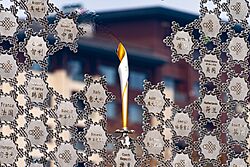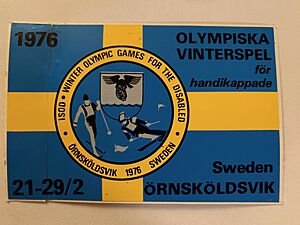Winter Paralympic Games facts for kids
Quick facts for kids Winter Paralympic Games |
|
|---|---|

One of the Paralympic cauldrons in Yanqing during the 2022 Winter Paralympics.
|
The Winter Paralympic Games is a major international event where amazing athletes with physical disabilities compete in snow and ice sports. These athletes may have challenges with moving, have lost a limb, have trouble seeing, or have cerebral palsy.
The Winter Paralympics happen every four years, right after the Winter Olympic Games. Since 1992, they have even taken place in the same city using the same venues. The International Paralympic Committee (IPC) is in charge of the Games. Just like in the Olympics, athletes win medals: gold for first place, silver for second, and bronze for third.
The first Winter Paralympics were held in 1976 in Örnsköldsvik, Sweden. These Games were special because they were the first to include athletes who were not in wheelchairs. Since then, the Games have grown to become one of the largest sporting events in the world.
Norway has won the most medals at four different Winter Paralympics. Germany has been the top country three times. Russia and the United States have each finished on top twice, while Austria and China have each done it once.
Contents
The Story of the Games
The idea for the Paralympics started with injured soldiers returning from World War II. A doctor named Ludwig Guttmann saw that sports could help them heal. In 1948, he organized sports competitions between hospitals in Great Britain. This led to the first Paralympic Games in Rome in 1960, which were held after the Summer Olympics.
The Winter Games were inspired by people like Sepp Zwicknagl, an Austrian skier who had lost both of his legs. He figured out how to ski using prosthetic (or artificial) legs. His work helped create new technology for people with disabilities who wanted to enjoy winter sports.
In 1974, the first world ski competition for athletes with physical disabilities was held. Two years later, the very first Winter Paralympics took place in Örnsköldsvik, Sweden, in 1976. Athletes competed in alpine (downhill) and Nordic (cross-country) skiing. Ice sledge racing was also shown as a demonstration sport. A total of 198 athletes from 16 countries took part.
Who Can Compete?
The IPC created six groups for disabilities to make sure the competition is fair. These groups are used for both the Summer and Winter Games.
- Amputee: Athletes who are missing part or all of at least one arm or leg.
- Cerebral Palsy: Athletes whose brains have difficulty controlling their muscles, balance, or coordination.
- Intellectual Disability: Athletes with a significant disability in their thinking and learning skills.
- Wheelchair: Athletes who need a wheelchair to compete, often because of a spinal cord injury.
- Visually Impaired: Athletes who have difficulty seeing. This can range from being partially blind to completely blind.
- Les Autres: This is French for "the others." This group is for athletes whose disability doesn't fit into the other categories, like dwarfism or multiple sclerosis.
How Athletes Are Classified

Within each disability group, athletes are classified again based on how much their disability affects them in their sport. This is like having weight classes in boxing or age groups in junior sports. It helps make the competition as fair as possible.
The classification system is different for each sport because each sport requires different skills. Here is a look at how some of the Winter Paralympic sports are classified.
Alpine Skiing
Alpine skiing includes fast downhill events like slalom and giant slalom. Athletes with many different types of disabilities can compete. There are eleven classifications: seven for standing athletes, three for sitting athletes, and one for visually impaired athletes. The groups are based on how well an athlete can move and what equipment they need, like special skis or poles.
Biathlon
Biathlon combines cross-country skiing and target shooting. Athletes need to be strong and have a steady hand. There are fifteen classes for athletes with physical or visual disabilities. To make it fair, an athlete's finishing time is adjusted using a special formula based on their disability class. Visually impaired athletes can use special headphones that make a sound to help them aim at the target.
Cross-Country Skiing
Also known as Nordic skiing, this sport is open to athletes in almost all disability categories. There are fifteen different classifications, which are set up in a similar way to alpine skiing.
Para Ice Hockey

Para ice hockey is a fast and exciting team sport for male athletes who have a disability in the lower part of their body. Athletes sit on special sleds with blades and use two sticks to push themselves across the ice and shoot the puck.
Wheelchair Curling
Wheelchair curling is a team event for both men and women. All athletes must use a wheelchair in their daily life. Players can slide the curling stone by hand or by using a special stick. There is only one classification: all players must need a wheelchair for daily movement.
Para Snowboarding
Para snowboarding became a medal event at the 2014 Winter Paralympics. Athletes compete in events like snowboard cross (a race down a course with turns and jumps) and banked slalom (a race through a curvy course). Athletes are grouped based on whether their disability affects their arms or legs.
Unfair Advantages
Most athletes compete fairly, but some have tried to cheat. This can include trying to make their disability seem worse than it is to get into a more favorable classification.
Another issue is a technique called "boosting," where athletes try to raise their blood pressure to improve their performance. This is dangerous and against the rules. The IPC works hard to catch any form of cheating to protect the athletes and the spirit of the Games.
In 2016, the IPC banned the entire Russian team from the Summer Paralympics. This was because of evidence of a widespread, state-sponsored doping program, which broke the anti-doping rules. The IPC said that the Russian government had "catastrophically failed its Para athletes."
List of Paralympic Sports
These are the sports that have been part of the Winter Paralympic Games.
| Sport | Years |
|---|---|
| Ice sledge racing | 1980–1988, 1994–1998 |
| Para alpine skiing | 1976–present |
| Para biathlon | since 1988 |
| Para cross-country skiing | 1976–present |
| Para ice hockey | since 1994 |
| Para snowboard | since 2014 |
| Wheelchair curling | since 2006 |
All-Time Medal Table
This table shows the top 20 countries that have won the most medals at the Winter Paralympics from 1976 to 2022. Countries are ranked by the number of gold medals they have won.
| No. | Nation | Games | Gold | Silver | Bronze | Total |
|---|---|---|---|---|---|---|
| 1 | 13 | 140 | 111 | 86 | 334 | |
| 2 | 13 | 117 | 130 | 88 | 335 | |
| 3 | 13 | 109 | 118 | 116 | 343 | |
| 4 | 9 | 109 | 85 | 81 | 275 | |
| 5 | 6 | 84 | 88 | 61 | 233 | |
| 6 | 13 | 79 | 51 | 62 | 192 | |
| 7 | 13 | 63 | 57 | 60 | 183 | |
| 8 | 13 | 58 | 52 | 76 | 186 | |
| 9 | 13 | 53 | 55 | 50 | 158 | |
| 10 | 4 | 42 | 43 | 35 | 120 | |
| 11 | 7 | 38 | 51 | 52 | 141 | |
| 12 | 13 | 28 | 35 | 44 | 107 | |
| 13 | 13 | 27 | 42 | 37 | 97 | |
| 14 | 6 | 19 | 20 | 23 | 62 | |
| 15 | 8 | 18 | 21 | 22 | 61 | |
| 17 | 12 | 17 | 7 | 11 | 35 | |
| 18 | 12 | 16 | 25 | 32 | 73 | |
| 19 | 12 | 15 | 16 | 12 | 43 | |
| 20 | 12 | 12 | 6 | 17 | 35 |
List of Winter Paralympic Games
| Games | Year | Host | Opened by | Dates | National Paralympic Committees | Competitors | Sports | Events | Top Nation | ||
|---|---|---|---|---|---|---|---|---|---|---|---|
| Total | Men | Women | |||||||||
| 1 | 1976 | King Carl XVI Gustaf of Sweden | 21–28 February | 16 | 196 | 2 | 53 | ||||
| 2 | 1980 | King Olav V of Norway | 1–7 February | 18 | 299 | 63 | |||||
| 3 | 1984 | President Rudolf Kirchschläger | 14–20 January | 21 | 419 | 3 | 107 | ||||
| 4 | 1988 | President Kurt Waldheim | 18–25 January | 22 | 377 | 4 | 97 | ||||
| 5 | 1992 | President François Mitterrand | 25 March – 1 April | 24 | 365 | 288 | 77 | 3 | 78 | ||
| 6 | 1994 | Queen Sonja of Norway | 10–19 March | 31 | 471 | 5 | 133 | ||||
| 7 | 1998 | Crown Prince Naruhito | 5–14 March | 32 | 571 | 122 | |||||
| 8 | 2002 | President George W. Bush | 7–16 March | 36 | 416 | 4 | 92 | ||||
| 9 | 2006 | President Carlo Azeglio Ciampi | 10–19 March | 39 | 486 | 5 | 58 | ||||
| 10 | 2010 | Governor General Michaëlle Jean | 12–21 March | 44 | 506 | 64 | |||||
| 11 | 2014 | President Vladimir Putin | 7–16 March | 45 | 550 | 6 | 72 | ||||
| 12 | 2018 | President Moon Jae-in | 9–18 March | 49 | 569 | 80 | |||||
| 13 | 2022 | President Xi Jinping | 4–13 March | 46 | 564 | 78 | |||||
| 14 | 2026 | 6–15 March | 79 | ||||||||
| 15 | 2030 | 1-10 March | |||||||||
| 16 | 2034 | 10–19 March | |||||||||
See also
 In Spanish: Juegos Paralímpicos de Invierno para niños
In Spanish: Juegos Paralímpicos de Invierno para niños
- Summer Paralympic Games


